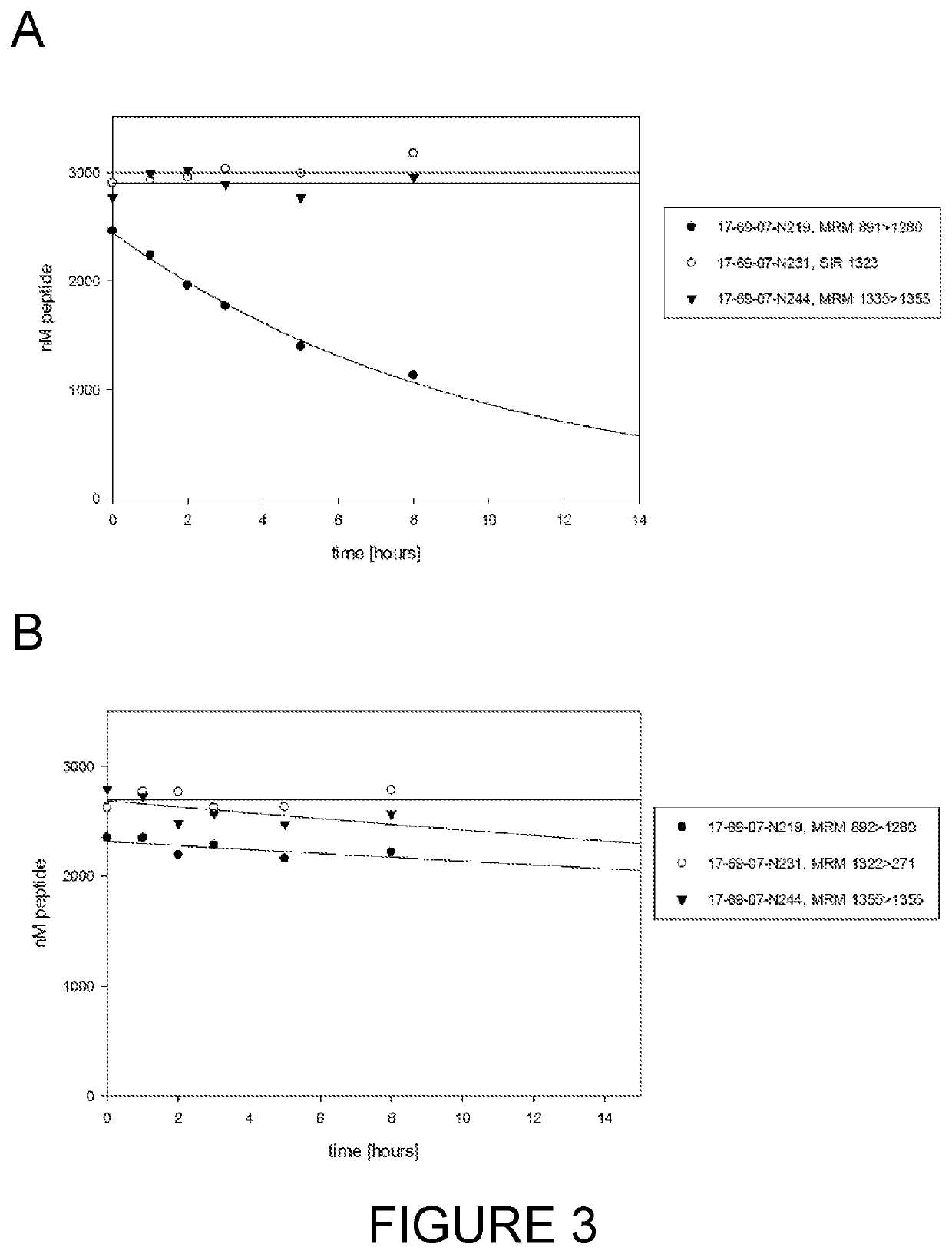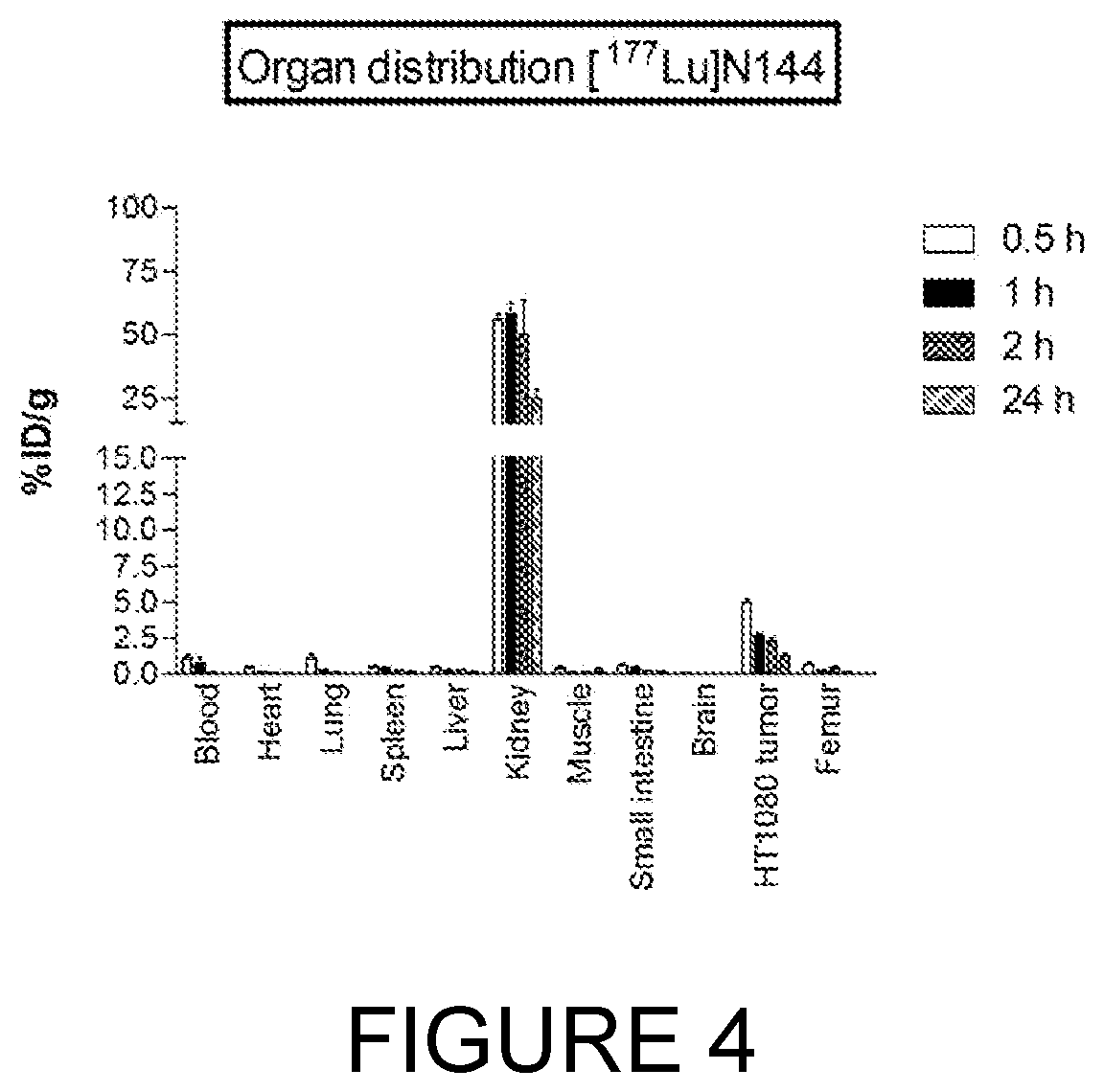Bicyclic peptide ligands specific for MT1-MMP
a peptide ligand, bicyclic technology, applied in the field of polypeptides, can solve the problem of reducing the conformational flexibility of the cyclic structur
- Summary
- Abstract
- Description
- Claims
- Application Information
AI Technical Summary
Benefits of technology
Problems solved by technology
Method used
Image
Examples
example 1
ation of Bicyclic Peptides with High Affinity Using MT1-MMP Hemopexin Domain
[0271]Employing previously established methods for generating bicyclic peptide phage libraries, selections were performed against the human hemopexin domain of MT1-MMP. Following three rounds of selections from a naïve library employing successively reduced concentrations of target, sequencing was performed on the outputs. Bicyclic peptide 17-69 (CKNRGFGCEDFYDIC) (SEQ ID NO: 16) was identified as one the most abundant sequence outputs, and qualitative binding to the target was verified by Alphascreen.
[0272]Three small phage libraries were generated providing full sequence coverage of each of 3 portions of the 17-69 sequence. These three libraries were subjected to two rounds of selections against hemopexin protein. Interestingly, the most promising sequencing outputs were 5×6 bicyclic peptides, while the starting libraries were of the 6×6 format. It is likely that the shorter loop length was selected due to ...
example 2
ic Stabilisation of the 17-69-07 Core Sequence
Mouse Plasma Stability of 17-69-07
[0285]For therapeutic applications in man, and for pre-clinical assessment in animal species, it is pertinent that a lead bicycle peptide is sufficiently stable in the circulation following intravenous administration. Adequate stability is required such that sufficient levels of bicycle peptide can bind to its target and exert its biological function.
[0286]Preclinical models often employ species such as mouse, rat, rabbit and cynomolgus monkey. In the first instance, the bicyclic peptide 17-69-07-N219 was assessed for stability in the presence of mouse plasma using methods described hereinbefore (Method #2). The bicycle core sequence retains the original natural proteinogenic amino acids of the 17-69-07 sequence, and additionally contains an N-terminal molecular spacer that is used for conjugation of effector groups (sequence: G-Sar10-ACYNEFGCEDFYDIC; SEQ ID NO: 20). The affinity of 17-69-07-N219 to PEX ...
example 3
nalysis of Proteolytically Stabilised Variants of 17-69-07 Conjugated to a Chelator
[0340]Peptides linked to metal chelators have multiple applications in diagnostics and therapeutics. Certain imaging or therapeutic radioisotopes can be “loaded” onto the chelator while the peptide carries said isotopes to the target. In this manner, tumour specific antigens can be visualised using, for example, PET and SPECT scanners. For targeted radiotherapy, therapeutic radionuclides (such as 90Y and 177Lu) are loaded onto the chelator-peptide and selectively carried to the tumour by binding the tumour-associated antigen. There they exert their anti-tumour activity by the high energy radiation they emit.
Synthesis of Chelator-Linked 17-69-07 Bicyclic Peptides
[0341]Five derivatives were synthesised where the metal chelator DOTA (1,4,7,10-tetraazacyclododecane-1,4,7,10-tetraacetic acid) was linked to the N-terminal Alanine of the 17-69-07 bicyclic peptide.
[0342]
TABLE 15Summary of the molecules and st...
PUM
| Property | Measurement | Unit |
|---|---|---|
| half life | aaaaa | aaaaa |
| weight | aaaaa | aaaaa |
| volumes | aaaaa | aaaaa |
Abstract
Description
Claims
Application Information
 Login to View More
Login to View More - R&D
- Intellectual Property
- Life Sciences
- Materials
- Tech Scout
- Unparalleled Data Quality
- Higher Quality Content
- 60% Fewer Hallucinations
Browse by: Latest US Patents, China's latest patents, Technical Efficacy Thesaurus, Application Domain, Technology Topic, Popular Technical Reports.
© 2025 PatSnap. All rights reserved.Legal|Privacy policy|Modern Slavery Act Transparency Statement|Sitemap|About US| Contact US: help@patsnap.com



